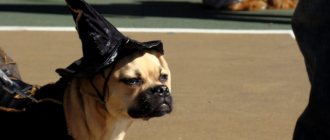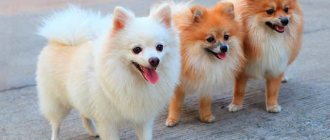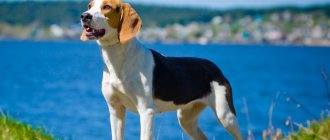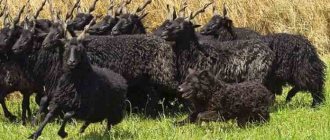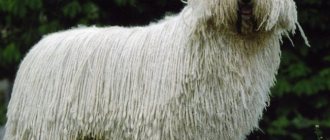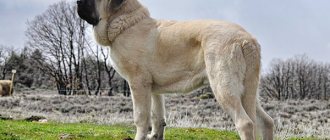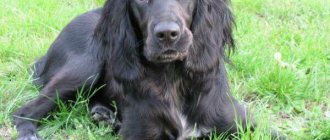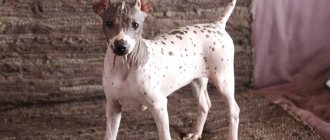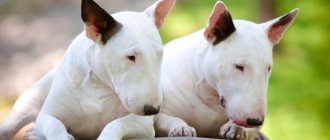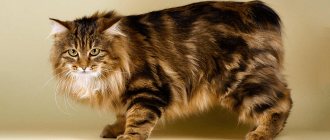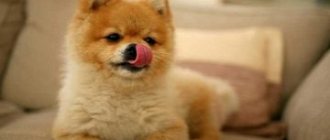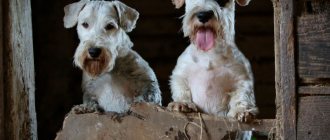Turkish Kangal breed
The Turkish Kangal dog is a breed of guard dog native to the city of Kangal in the province of Sivas, Turkey. This is a mastiff-like dog, with a solid, yellow-brown coat color, and a black mask on its face.
According to the standards of the official fan organizations in Turkey, Cynology Federation Of Turkey (KIF) and Ankara Kangal Derneği (ANKADER), dogs may have white markings and may not have a mask.
Although they are most often described as herding dogs, this is not the case; they are guard dogs, protecting the herd from wolves, jackals and bears. Their protective qualities, loyalty and gentleness with children and animals, have led to an increase in popularity as a protector of the family.
History of the breed
The name comes from the city of Kangal, in the province of Sivas, and probably has similar roots to the Turkish name of the Kanli tribe. The origin of the toponym that gave its name to the dog and the city is still unclear. Probably, the Kanly tribe left Turkestan and migrated to Anatolia, forming the village of Kangal, which has survived to this day.
Thus, dogs are more likely to come from Turkestan rather than Turkey. The hypotheses that they are of Babylonian or Abyssinian origin are not confirmed by geneticists.
The version that these dogs originated from a pair of Indian dogs taken to Turkey is not seriously considered.
One thing is clear that this is an ancient breed that has been serving people for a very long time. It’s just that human intrigues are intertwined with its history, where different countries and peoples arrogate to themselves the right to be called the homeland of these dogs.
There are subtle differences in the breed standard used in different countries. In the homeland of dogs, Turkey, the standard of the Cynology Federation of Turkey describes the height of the dog from 65 to 78 cm, plus or minus two centimeters.
However, KIF does not distinguish between males and females. Although the standards of other countries are fairly well harmonized with each other, they are not the same as the KIF standard. In the UK, the height at the withers for males should be from 74 to 81 cm, for females from 71 to 79 cm, excluding weight.
In New Zealand, for males the height is indicated from 74 to 81.5 cm, and weight from 50 to 63 kg, and for females from 71 to 78.5 cm, with a weight from 41 to 59 kg. In the USA, this breed is only recognized by the UKC, and the standard describes males from 76 to 81 cm at the withers, weighing from 50 to 66 kg and females from 71 to 76 cm, and weighing from 41 to 54 kg.
Turkish Wolfhounds are not as heavy as other mastiffs, giving them an advantage in speed and endurance. So, they can accelerate up to 50 km per hour.
Their undercoat provides protection from the harsh Anatolian winters and hot summers, while the outer coat protects against water and snow. Such wool allows you to regulate body temperature well, while being dense enough to protect against the fangs of wolves.
The differences between the KIF standard and the international ones also affected the colors. Both official organizations, Cynology Federation Of Turkey (KIF) and Ankara Kangal Derneği (ANKADER), do not consider coat color to be a distinctive feature of the breed.
Black and white spots and longer coats are not considered signs of crossbreeding; the KIF standard is completely tolerant of coat color, and a little more picky about white spots. They are allowed only on the chest and on the tip of the tail, while in other organizations they are also allowed on the paws.
But in other clubs, the coat and its color are the most important features that distinguish the breed from Akbash and Anatolian Shepherds.
It should be short and dense, not long or fluffy, and the color should be grey-yellow, grey-brown or brown-yellow.
All dogs must have a black mask on their face and black markings on their ears. Depending on the standards, white markings on the chest, legs and tail may or may not be allowed.
Ear cropping is done for several reasons, including for protection, since they can become a target for the enemy in a fight.
It is also believed that this way their hearing improves, since it is easier for sound to get into the shell. However, ear cropping is illegal in the UK.
Dogs of this breed are calm, independent, strong, in control and highly protective. They may not be friendly to strangers, but a well-trained Kangal gets along with them, especially children.
He always controls the situation, is sensitive to its changes, and responds to threats instantly and adequately. They are excellent protectors for both livestock and people, but are not suitable for inexperienced dog owners, as their independence and intelligence make them poor learners.
When guarding the herd, these dogs occupy a height from which it is convenient to view the surroundings. On hot days, they may dig holes in the ground to cool off.
Young dogs stay close to old ones and learn from the experience. They usually work in pairs or groups, depending on the size of the flock. At night, the intensity of their patrols increases.
When alarmed, the kangal raises its tail and ears and signals to the sheep to gather under its protection. His first instinct is to put himself between the threat and the owner or herd. Once the sheep have gathered behind him, he controls the invasion.
Turkish Kangal dog. Description, features, care and price of Turkish Kangal
The oldest breed of Turkish Kangal is the most beloved animal of Turkish shepherds. They earned deep respect thanks to their courage and lightning speed of reaction.
Turkish Kangal dogs are distrustful, but at the same time they have an amazingly balanced character. For this pet, life in a country house is more acceptable than in an apartment, where there is little space, which he likes so much. These dogs are a real national treasure of Turkey.
Some experts have long been considering the issue of uniting all herding dogs into one breed, but in Turkey this proposal is viewed negatively; they seriously monitor the purity of the breed. Moreover, Turkish Kangal are prohibited from being exported from Turkey to avoid mixing their breed with others.
But it is not known in what way, yet in the 80s of the 20th century, dogs were taken out of the country and slowly began to spread throughout the world, they became popular first in America, then they learned about all the charms of this breed in Europe. There is an old small area in Turkey called Kangal, and these dogs were named after it.
How to choose a puppy
It is impossible to purchase a purebred Kangal puppy in our country. But there are representatives of this breed on the dog breeding market, which were obtained by crossing purebred Kangal with other comparable types of herding dogs. If these puppies are compared with each other, the differences will be insignificant.
Kangal Shepherd puppies
For example, if we compare the Kangal and the Alabai, it will be difficult to distinguish the puppies from each other. Differences will begin to be determined only in adulthood. Kangal and Alabai can only differ in different colors.
Puppies should only be purchased from nurseries that officially breed them. Preference should be given to healthy, active and moderately well-fed representatives of the breed.
Note! It is not recommended to pick up a puppy before two months.
Breed characteristics and character
Kangals are distinguished by their unpretentiousness. They are real hard workers and are called upon to help and serve humanity in the harshest conditions, without requiring any intense courtship.
From the stories of many shepherds, it is known that the Turkish Kangal Shepherd can guard a found sheep for several days, without eating or drinking.
There was more than one known case when the Kangals won in a duel with a wolf who had his eyes on a sheep. Then the shepherd, as a sign of gratitude, slaughtered the largest ram and gave it to his faithful dog.
They have an independent character. For them, only a real, strong-willed and internally strong owner can become a great example. When raising a pet from a young age, you should not become embittered.
Harsh training methods can turn the Kangal into a real unbridled dog. He is easy to learn and can be trained, the main thing is to be persistent, diligent and not cruel. In order for a dog to grow up normal, it must initially live in an environment with people and its relatives.
As for the relationship between Turkish Kangal puppies and children, they are always friendly. Despite their impressive size and peculiar disposition, Kangals treat children's quirks with understanding and love and can withstand the tugging of their tail. The main thing is to make it clear to your child that a dog is also a living creature that cannot be hurt.
The dog is not suitable for living in an apartment. They need space and a place where they can accelerate. Otherwise, she simply becomes aggressive, irritable and angry. They need space, movement and livestock to keep an eye on. This is the essence of the purpose.
In a country house, this will be the most reliable security guard. There is plenty of space for the dog to run around and enjoy life. It is important to make it clear to him at the beginning of communication with the Kangal that in a dog-human pair the leader is the human. Then playing and training with the puppy will be beneficial.
They are terrible workaholics. They defend their territory or the object entrusted to them until their last breath. As for their guard qualities, they can only be compared in this with the Moscow guards.
If the Turkish Kangal dog breed is sufficiently provided with physical activity and work, they simply will not have the energy left for aggression and bad behavior. Such dogs have a stable psyche and an even, friendly relationship with all household members.
They are independent and freedom-loving. Not everyone can control them; in some cases, professional advice is needed. You can often watch the currently popular dog fights; the Turkish Kangal takes direct part in them, and emerges victorious over his frequent rivals, the Alabais.
What and how to feed the Anatolian Shepherd
When raising a Turkish dog, it is important to provide it with proper nutrition from puppyhood. Only in this case will the dog grow up healthy and not have problems with joints and bones.
If you feed the Kangal with natural food, then the menu should mainly consist of fish, meat and offal, since they contain the required amount of proteins and components beneficial to the health of the pet. Also, the menu should be supplemented with cereals, vegetables and herbs.
Important! It is not recommended to overfeed your dog. This is especially true when feeding dry food. When feeding, you must strictly follow the table indicated on the product packaging.
The pet must be provided with plenty of water, as representatives of this breed drink a lot of it. It is recommended to change the water at each feeding.
Description of the Turkish Kangal breed (standard requirements)
A photo of a Turkish Kangal shows all its power and beauty. In real life, these qualities are doubled. Breed standards are slightly different in each country. But generally the height of the dog at the withers reaches up to 90 cm.
The average weight of Kangals is from 35 to 75 kg. They are endowed with a strong physique, with a powerful neck and strong limbs. Basically, females are always smaller than males.
Dogs have thick, short hair with undercoat. The coat color includes gray-yellow, brown with yellow and gray-brown tones. White color is unacceptable for the breed.
The muzzle must be decorated with a black mask. Despite its massive and impressive size, the dog controls its body with ease and without problems. The kangal moves easily, naturally and energetically. The average life expectancy of this breed is up to 15 years.
Care and maintenance of the Turkish Kangal
Before buying a Turkish Kangal, a person should assume whether the dog will feel comfortable and comfortable? As already mentioned, city residents living in an apartment should not even think about this, so as not to torment the dog.
The countryside, a country house - this is exactly what the Kangals need for a good life. They always like long walks and training. Hard work is the main thing that was inherent in these dogs. Without work and physical activity, they will simply get bored and “get out of hand.”
Bathe your pet as needed. They need to be combed with a special comb several times a week. Living conditions for this breed are not important. They are comfortable under any temperature changes and in any conditions.
When it comes to choosing food, the dog owner has the final say. You can stop him on natural food consisting of meat, fish, vegetables and fruits or give preference to dry food.
In any case, their food should be high in calories and contain a sufficient amount of nutrients. This is the only way the pet will grow up healthy, strong and cheerful. Leashes for Kangals are not acceptable. They need an area where they can safely walk, frolic and exercise.
In general, this breed has excellent health and well-being. Sometimes they may be subject to bone diseases and eye problems. But with proper monitoring of the situation and timely visits to the veterinarian, these problems can be avoided.
Health and life expectancy
Puppies look like bear cubs.
A shepherd dog, seasoned in battles with predators, not spoiled by special care, can boast of excellent immunity and health - they have been passed on even to distant descendants.
Therefore, infectious and colds rarely cause problems for your pet.
The main problems are joint dysplasia (alas, the lot of all large dogs) and diseases affecting the eyes.
Attention! A sufficient amount of calcium in a dog’s diet (cottage cheese, kefir) reduces the risk of developing joint dysplasia.
If you monitor your pet’s health, provide appropriate care and promptly contact a veterinarian, the dog can live on average 12-15 years, which is a very good indicator for large breeds.
Price and reviews of Turkish kangal
You can find a dog for yourself at a special market or in Internet advertisements. In frequent cases, there are photos and videos of dogs. But there is no guarantee that the puppy will actually be of a purebred breed.
In order to buy a real Kangal, it is better to contact specialized nurseries, where they have all the pedigree and other necessary information about the dog. Plus, in such establishments they begin to vaccinate the dog from a very early age, which is very important for its health.
The price of Turkish kangal is quite high. A small puppy costs from $1000. And this is not surprising for such a beautiful breed, the reviews of which are the most positive. All their breeders unanimously say that Kangals are excellent guards and working dogs. They are the ideal help and support for a person.
Only some of the difficulties that arise when keeping Kangals confuse people - these are considerable costs to feed them and the complete impossibility of keeping a dog in a city apartment.
Pros and cons of the breed
Of course, the Turkish Kangal is an interesting and even exotic dog.
Note! Before getting such a pet, it would be a good idea to carefully study the characteristics of the breed, and first of all, its strengths and weaknesses.
The main advantages are considered to be:
- endurance,
- fearlessness,
- strong immunity,
- serious appearance
- balanced, calm character.
But at the same time, the Kangal is a breed that has certain disadvantages, for example:
- high cost of a purebred dog,
- difficulty of training,
- expensive maintenance (the dog eats a lot),
- not suitable for apartments.
Therefore, before getting this pet, you should think carefully about everything, weigh the strengths and weaknesses, so as not to later regret a bad decision.
Description of Turkish Kangal
In their homeland (Turkey), pets are distinguished by color and divided into three types. Karabash is considered the most common - the color can be brindle, tricolor or black. There is also Akbish. This is a variety of white kangal with guard skills. The third type is the Kangal, which has a black mask and the same ears.
The breed standard is guessed in the following description:
- The dog is tall, its height can reach 80 cm, and its weight can be 65 kg.
- The physique is strong and muscular, the body is strong.
- The heavy, not small head is wide in shape.
- There are small dewlaps in the mouth area, and the dog has a scissor bite.
- The neck is powerful.
- The limbs are quite straight and stable.
- The coat has a soft, dense undercoat, is dense and short.
- The color of the Kangal coat can be of three types: yellow-brown, gray-brown, yellow-gray.
The impressive size of the Turkish Kangal helped him get into the ranking of the largest dogs in the world along with St. Bernards, Newfoundlands, mastiffs and other massive breeds.
In all its movements the huge dog is energetic and free. The pet's neck and head are kept in line with its back while it walks. Therefore, it seems that the Turkish Kangal is sneaking, not walking.
Any deviations from the given descriptions are considered a defect in the breed. Also, if there are mental abnormalities in the behavior of a pet, it can be disqualified from the ranks of a noble breed. After all, this dog is not characterized by either cowardice or aggression. She is always calm and balanced.
If a pet is born in a natural environment, its ears are torn off. This is considered animal cruelty. Such pets permanently receive psychological trauma and become aggressive.
Who is the breed not suitable for?
Kangal dogs are not recommended for city residents and beginners in dog breeding. From the description of the Kangal Shepherd, you can immediately understand that such a huge dog will feel uncomfortable in the limited space of a city apartment.
Also, those who have no experience raising dogs should not purchase Kangal puppies. Only an experienced person who has experience in training and education, and also has a strong character, can cope with such a pet.
Origin story
Kangal is a very ancient breed. The Anatolian Shepherd lived on the lands of Asia Minor tens of hundreds of years ago. The dog has always been respected for its independent and flexible character. And the impressive size of the pet aroused people’s admiration.
The first mentions of the Turkish kangal date back to the time of the existence of ancient Babylon. At that time, Anatolian Karabash were used as hunters and warriors. Dogs were taken to hunt wild horses and lions. The Kangals were not afraid of wolves and meekly drove them away from the herd of cattle.
There is a version that the breed originally appeared in Turkey, since its name was given in honor of its place of origin - in the Anatolian Plateau.
And although the name indicates Turkish roots, the Turks themselves do not agree that the kangal is Turkish.
There are many varieties of dogs living in Turkey, which are considered the ancestors of the breed based on external characteristics. Some scientists argue that the dogs may have Belgian roots. There, in their opinion, the breed was created by selection.
But this information is just speculation that is not confirmed by facts. In the meantime, it is known that the breed came to Belgium more than 200 years ago.
Education and training
The Anatolian Karabash is prone to dominance if he feels that the person in front of him is not confident in himself. You need to raise your pet patiently, showing him that he is not the head of the family, but the owner. In no case should violence or cruelty be used, so as not to hurt the puppy’s soul.
This dog needs a lot of space, so it is unacceptable to keep it in an apartment. Early socialization and constant physical activity and running are important for your pet. And organizing them within the city is almost impossible.
The dog will treat strangers with distrust and wariness. However, you need to teach her not to attack or bark at those who approach her owners.
From the first month of life, the dog is given classes, persistently repeating the necessary commands. But if the task seems pointless to the dog, then the independent individual will not carry it out. Then you need to leave the lesson “for later” and move on to another lesson.
You can go through an OKD course with a Turkish Kangal, then he will quickly become obedient.
You won't have to stop dogs from barking again. They never raise their voices without a reason. You can hear the kangal barking only under serious circumstances.
If the need arises, the dog will desperately protect the person.
Caring for the Turkish Kangal
This pet can cope with the task of protecting the house perfectly. It can be kept not only indoors, but also in the local area if there is a spacious and insulated enclosure. But you can't keep your pet on a leash. An independent dog needs freedom of movement. So, she will not leave her possessions without her owner.
The breed does not require special care. A pet dog will need to wash its paws after going outside. However, this breed loves swimming in ponds. Especially, together with its owner. Therefore, in the cold season, your pet can be bathed in the bathtub, and in the summer - in the river.
During periods of shedding, the dog sheds profusely. The rest of the time, the hair also falls out, so you will have to comb it out once a week with a comb and a rubber glove.
A small Anatolian Shepherd puppy should immediately have its own place in the house: bedding, a corner with toys, food bowls in the kitchen.
The huge animal loves to sleep on the bed with its owner. But it is better to wean puppies from this habit. Because soon he will weigh a lot and sleeping with him will become uncomfortable.
If the dog lives in a house or spacious apartment, it needs to be given three walks a day. Your pet needs to empty its stomach twice a day. This factor will indicate the health of the pet. If a dog goes to relieve itself once a day, this indicates health problems. The dog's ears are periodically cleaned and the eyes are washed out of mucus.
The Turkish Kangal is not a picky eater, but it is better to prepare his food yourself.
The main role in the diet is given to meat. There should be more of it in every meal than other ingredients. You can serve your dog the following dishes:
- Meat with porridge.
- Offal.
- Meat with vegetable stew.
Servings should be sufficient and food should be fresh. In addition, Kangals are fed cottage cheese, sour cream, raw eggs, fish, fruits and herbs.
Adults are given food up to 2 times a day, and puppies - up to 6 times. It is advisable to feed your dog at the same time every day. It is important to know that this breed is prone to obesity. Therefore, the four-legged dog should not be overfed.
You can add vitamin and mineral complexes to your natural diet. In addition, it is permissible to feed a puppy and an adult dog with high-quality food: dry and wet.
Your dog should always have plenty of drinking water available. It is customary to change it in the bowl twice a day.
It is worth noting that the big dog is very neat and clean. She will not stir up dirt while eating.
How to organize proper pet care
In many ways, how happy the dog will be and how many years he can live depends on whether the owner provides him with suitable care. And for each breed there are certain nuances that are very important for the breeder to know about.
What and how to feed the Anatolian Shepherd
On cheap dry food, the kangal will not grow as big and strong as it could. And analogues from the premium segment will simply ruin the breeder - the dog eats a lot. Therefore, it is best to opt for homemade food.
Of course, the basis should be animal proteins. Lean meat, fish (only sea fish and without large bones) and offal are good options.
Carbohydrates are also important - it is best to prepare a tasty porridge mixed with chopped meat. Buckwheat, millet, and rice are suitable here.
Finally, we must not forget about the vitamins that vegetables such as carrots and pumpkin are rich in. It is advisable to give them raw, thoroughly crushed and mixed with main dishes.
Attention! With little mobility, the dog quickly gains excess weight, so you need to feed your pet in moderation.
Walk
The dog should walk a lot and often. Therefore, as mentioned above, it is better not to keep it in apartments at all. Of course, it will be better if she has the opportunity to run around the entire area around the owners’ house. If the kangal lives in an enclosure, then you need to let it out at least twice a day for at least 40-60 minutes. Then the pet will run around to its heart's content, burn off extra calories and sleep better, feel better and get sick less often.
Hygiene
Short hair needs to be brushed at least once every week or two, and more often during shedding. It is better not to use a regular brush; a special glove that effectively collects loose hair will do. If this is not done, the dog will itch all the time and will not feel very comfortable.
There is no need to trim your nails - they already wear off just fine with regular jogging.
But you need to pay attention to your ears - it is advisable to clean them every week. Moreover, the procedure does not take much time and effort. Armed with a cotton swab dipped in hydrogen peroxide, you need to carefully clean the ear from wax and any other contaminants.
Finally, the teeth. If you give your pet a stick, a bone or a suitable toy, then you don’t have to think about this aspect of hygiene - the dog will brush his teeth just fine. Otherwise, a couple of times a month you will have to arm yourself with a brush and clean it. Otherwise, the dog will lose his teeth, and this will affect his well-being and longevity.
Loving mother with children
Mating
Like most large dogs, the Kangal matures rather slowly. Therefore, it is advisable to allow males who are at least one and a half years old to be mated, and females who are 2 years old and older. Otherwise, childbirth may harm the bitch, and the health of the puppies may suffer.
For reference! Further mating can be carried out every year and a half up to 7-8 years.
